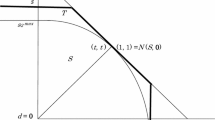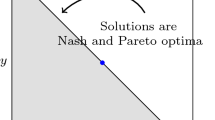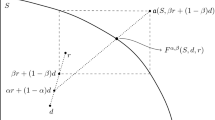Abstract
We show that in the one-dimensional bargaining model based on the protocol of Baron and Ferejohn (Am Polit Sci Rev 83:1181–1206, 1989), if voting is simultaneous, publicly observed, and no agent has the power to unilaterally impose a choice, then arbitrary policies can be supported by subgame perfect equilibria in stage-undominated voting strategies when agents are patient. Moreover, in the model with a bad status quo, arbitrary outcomes can be supported for arbitrary positive discount factors. We formulate sufficient conditions for supporting arbitrary alternatives in terms of a system of equations. The system has a straightforward solution in the model with no discounting, and after verifying non-singularity of this system, we use the implicit function theorem to derive the folk theorem when agents are sufficiently patient.
Similar content being viewed by others
Notes
Banks and Duggan (2000; 2006) establish existence of stationary equilibrium and convergence to the median ideal alternative as agents become patient. Cho and Duggan (2003) and Cardona and Ponsati (2011) prove uniqueness of stationary equilibria in a class of one-dimensional models. See Eraslan (2002) and Eraslan and McLennan (2013) for uniqueness results in the distributive model. The latter paper assumes sequential voting while the others use simultaneous voting with stage-undominated strategies. This distinction is inconsequential in the analysis of stationary equilibria as we mention below.
The bargaining model assumes that proposers choose from a continuum of alternatives, and for each possible proposal, the subsequent voting stage must be identified by a corresponding state. Because the game ends once a proposal is accepted, the bargaining model admits absorbing states, violating irreducibility.
Dutta (1995) shows that the set of equilibrium outcomes is monotonic in discount factor for stochastic games with a deterministic transition satisfying the condition that each player’s worst equilibrium across states and equilibria is weakly decreasing in the discount factor; in addition, he implicitly assumes this worst payoff is achieved at some state and for some equilibrium.
By continuous differentiability, we mean that \(u_{i}\) extends to a \(C^{1}\) function on an open superset of \(X\).
If the endpoints \({\underline{x}}\) and \({\overline{x}}\) do not satisfy this condition, our arguments can be adapted to any subinterval \(Z=[{\underline{z}},{\overline{z}}] \subseteq X\) with endpoints satisfying the restriction. The existence of alternatives in \(X \setminus Z\) increases the number of one-shot deviations, but when \(\delta \) is close to one, these will not be profitable given our construction.
In the model with a bad status quo, every interior alternative Pareto dominates the status quo, and the folk theorem result indeed extends to unanimity rule. In particular, the proof of Lemma 1, below, can then be modified to cover unanimity rule, in which case equilibrium strategies must include plans that punish each voter when that voter alone rejects an equilibrium proposal.
See Cho and Duggan (2009) for the formal development for a similar game.
References
Baron D, Ferejohn J (1989) Bargaining in legislatures. Am Polit Sci Rev 83:1181–1206
Banks J, Duggan J (2000) A bargaining model of collective choice. Am Polit Sci Rev 94:73–88
Banks J, Duggan J (2006) A general bargaining model of legislative policy-making. Q J Polit Sci 1:49–85
Cardona D, Ponsati C (2011) Uniqueness of stationary equilibria in bargaining one-dimensional policies under (super) majority rules. Games Econom Behav 73:65–75
Cho S, Duggan J (2003) Uniqueness of stationary equilibria in a one-dimensional model of bargaining. J Econom Theory 113:118–130
Cho S, Duggan J (2009) Bargaining foundations of the median voter theorem. J Econom Theory 144:851–868
Duggan J, Fey M (2006) Repeated downsian electoral competition. Int J Game Theory 35:39–69
Duggan J (2014) A folk theorem for repeated elections with adverse selection. Polit Sci Res Methods 2:213–242
Dutta P (1995) A folk theorem for stochastic games. J Econom Theory 66:1–32
Eraslan H (2002) Uniqueness of stationary equilibrium payoffs in the Baron-Ferejohn model. J Econom Theory 103:11–30
Eraslan H, McLennan A (2013) Uniqueness of stationary equilibrium payoffs in coalitional bargaining. J Econom Theory 148:2195–2222
Fudenberg D, Maskin E (1986) The folk theorem for repeated games with discounting or with incomplete information. Econometrica 54:533–554
Fudenberg D, Yamamoto Y (2011) The folk theorem for irreducible stochastic games with imperfect public monitoring. J Econom Theory 146:1664–1683
Fudenberg D, Levine D, Maskin E (1994) The folk theorem with imperfect public information. Econometrica 62:997–1040
Herings J-J, Meshalkin A, Predtetchinski A (2012) “A Folk Theorem for Bargaining Games”, Maastrict University working paper RM/12/055
Horner J, Sugaya T, Takahasi S, Vielle N (2011) Recursive methods in discounted stochastic games: an algorithm for \(\delta \rightarrow 1\) and a folk theorem. Econometrica 79:1277–1318
Norman P (2002) Legislative bargaining and coalition formation. J Econom Theory 102:322–353
Rubinstein A (1982) Perfect equilibrium in a bargaining model. Econometrica 50:97–109
Wen Q (2002) A folk theorem for repeated sequential games. Rev Econom Stud 69:493–512
Acknowledgments
We thank Hulya Eraslan and the anonymous editor and referees for helpful comments. All errors and omissions are our own.
Author information
Authors and Affiliations
Corresponding author
Proof of Lemma 1
Proof of Lemma 1
Lemma 1
Let \(\varvec{\delta }\in (0,1)^{n}\). If \(\mathbf Y \in \Omega ^{n}\) is plausible at \(\varvec{\delta }\), then \(\times _{i \in N} \text{ int } Y_{i}\subseteq X(\varvec{\delta })\).
Proof
Let \(\varvec{\delta }\in [0,1)^{n}\) and let \(\mathbf Y \in \Omega ^{n}\) be plausible at \(\varvec{\delta }\). Let \((y_{1},\ldots , y_{n})\in \times _{i\in N} (\text{ int }Y_{i})\). It suffices to show that there exists \(\sigma \in \Sigma (\varvec{\delta })\) such that for each \(i\in N\), agent \(i\) proposes \(y_{i}\) in the first period, and it is accepted. Our equilibrium construction relies on the definition of three mappings, denoted \(\alpha ^{j}_{i}\), \(\beta ^{k}_{i}\), \(\gamma ^{k}_{i}\) from alternatives to alternatives for each \(i,j,k \in N\).
To define the mappings \(\alpha ^{j}_{i}\), note that for every \(j\in N\), strict quasi-concavity of \(u_{j}\) implies that the minimum of \(u_{j}\) in \(Y_{j}\) is attained at a boundary point of the interval. Thus, for all \(x\in \text{ int }Y_{j}\), we have \(u_{j}(x) > \min _{z\in Y_{j}}u_{j}(z)\), and since \(\mathbf {Y}\) is plausible, the inequality \(u_{j}(x) > \delta _{j}\sum _{i\in N}\rho _{i}\min _{z_{i}\in Y_{i}}u_{j}(z_{i})\) then holds. Continuity of \(u_{j}\) then implies that for each \(i,j \in N\), we can define a mapping \(\alpha ^{j}_{i}:\text{ int }Y_{j}\rightarrow \text{ int }Y_{i}\) such that for each \(x\in \text{ int } Y_{j}\) and each \(k\in N\), we have \(\alpha ^{j}_{i}(x) \ne \hat{x}_{k}\), and so that in addition we have
Note that if agent \(j\) compares having \(x\) as the immediate outcome to rejection and having each \(i\) propose and pass \(\alpha ^{j}_{i}(x)\) in the next period, then the agent strictly prefers the former to the latter. In our equilibrium construction, we understand \(\alpha ^{j}_{i}(x)\) to be an alternative proposed by agent \(i\) if agent \(j\) was supposed to propose \(x\) in the preceding period and agent \(j\)’s proposal is not accepted; in equilibrium, this happens only when agent \(j\) deviates from proposing \(x\), so \(\alpha ^{j}_{i}(x)\) acts to punish such deviations.
For each \(i,k\in N\), define the mapping \(\beta ^{k}_{i} :\text{ int }Y_{i} \rightarrow X\) by
Thus, if \(x < \hat{x}_{k}\), for example, then \(\beta ^{k}_{i}(x)\) is located between \(x\) and \(\hat{x}_{k}\), so that \(u_{k}\left( \beta ^{k}_{i}(x)\right) >u_{k}(x)\). We understand \(\beta ^{k}_{i}(x)\) to be the alternative proposed by agent \(i\) to reward agent \(k\) if the proposer in the previous period proposed the correct alternative, if this was rejected by all agents but agent \(k\), and if \(x\) would be the current proposal dictated by \(\alpha ^{j}_{i}\); this essentially moves the current proposal toward the ideal point of agent \(k\), while remaining within the set \(Y_{i}\) for the current proposer.
Define the mapping \(\gamma ^{k}_{i}:\text{ int }Y_{i} \rightarrow X\) by
Thus, if \(x < \hat{x}_{k}\), for example, then \(\gamma ^{k}_{i}(x)\) is located between \(\min Y_{i}\) and \(x\), so that \(u_{k}\left( \gamma ^{k}_{i}(x)\right) <u_{k}(x)\). We understand \(\gamma ^{k}_{i}(x)\) to be the alternative proposed by agent \(i\) to punish agent \(k\) if the proposer in the previous period proposed the wrong alternative, if this was rejected by all agents but agent \(k\), and if \(x\) would be the current proposal dictated by \(\alpha ^{j}_{i}\); this essentially moves the current proposal away from the ideal point of agent \(k\), while remaining within the set \(Y_{i}\) for the current proposer.
To construct an equilibrium \(\sigma \) such that each agent \(i\) proposes \(y_{i}\) in the first period and it is accepted, we define proposal and voting strategies as follows. For each \(i\in N\), we let \(\mathbf {b}^{i}=(b^{i}_{1},\ldots ,b^{i}_{n})\in \{a,r\}^{n}\) denote the voting profile such that \(b^{i}_{i}=a\) and \(b^{i}_{j}=r\) for all \(j\in N\setminus \{i\}\). Now, for each \(i\in N\), define the proposal strategy \(p_{i} :H^{pi}\rightarrow X\) so that for each \(t=1,2,\dots \) and each \(h_{t}\in H^{pi}_{t}\),
-
1.
\(p_{i}(h_{1})=y_{i}\),
-
2.
if \(t=2,3\dots \) and for some \(h_{t-1}\in H^{pj}_{t-1}\), \(x\in X\), and \(\mathbf {b}\in B\), we have \(h_{t}=(h_{t-1},x,\mathbf {b},i)\), then
$$\begin{aligned} p_{i}(h_{t})=\left\{ \begin{array}{ll} \alpha ^{j}_{i}\left( p_{j}(h_{t-1})\right) &{} \quad \text{ if } \,\, \mathbf {b}\ne \mathbf {b}^{k} \text{ for } \text{ all } \,k\in N,\\ \beta ^{k}_{i}\left( \alpha ^{j}_{i}\left( p_{j}(h_{t-1})\right) \right) &{} \quad \text{ if } \,\, \mathbf {b}=\mathbf {b}^{k} \text{ for } \text{ some }\,k\in N \text{ and } \,x=p_{j}(h_{t-1}),\\ \gamma ^{k}_{i}\left( \alpha ^{j}_{i}\left( p_{j}(h_{t-1})\right) \right) &{} \quad \text{ if } \,\, \mathbf {b}=\mathbf {b}^{k} \text{ for } \text{ some } \,k\in N \text{ and } x\ne p_{j}(h_{t-1}).\end{array}\right. \end{aligned}$$
In particular, if agent \(j\) is supposed to propose \(p_{j}(h_{t-1})\) in period \(t-1\), if the agent’s proposal is rejected, and if there is not exactly one vote to accept, then agent \(i\) proposes \(\alpha ^{j}_{i}\left( p_{j}(h_{t-1})\right) \) to punish \(j\). If agent \(j\) proposes the correct alternative and exactly one agent, say \(k\), accepts \(j\)’s proposal, then \(i\) rewards \(k\) with \(\beta ^{k}_{i}\left( \alpha ^{j}_{i}\left( p_{j}(h_{t-1})\right) \right) \). And if agent \(j\) proposes the incorrect alternative and exactly one agent \(k\) accepts it, then \(i\) punishes \(k\) with \(\gamma ^{k}_{i}(\alpha ^{j}_{i}(p_{j}(h_{t-1})))\). The effectiveness of these proposal strategies stems from the fact that by our specification of voting strategies, below, agent \(j\)’s proposal is rejected if and only if the agent proposes \(x \ne p_{j}(h_{t-1})\), in which case it is rejected by a unanimous vote.
For each \(k \in N\), define the voting strategy \(v_{k} :H^{v}\rightarrow \{a,r\}\) so that for every \(j\in N\), every \(h\in H^{pj}\), and every \(x\in X\),
That is, if the correct alternative \(p_{j}(h)\) is proposed then all agents accept, and otherwise all agents reject.
Let \(\sigma =(p_{i},v_{i})_{i\in N}\). Since each agent \(i\) proposes \(y_{i}\) initially and all agents accept the proposal, it remains to be shown that \(\sigma \in \Sigma (\varvec{\delta })\). Consider any \(j\in N\) and any \(h\in H^{pj}\). Note that by construction, \(p_{j}(h)\in \text{ int }Y_{j}\). By the construction of voting strategies, \(p_{j}(h)\) passes if proposed, implying \(U^{\sigma }_{j}(h,p_{j}(h)|\varvec{\delta })= \delta ^{\tau (h)-1}_{j}u_{j}(p_{j}(h))\). Now consider any \(x\ne p_{j}(h)\). If agent \(j\) deviates and proposes \(x\) at \(h\), then the outcome of voting is \(v(h,x)=(r,\ldots ,r)\) and so, in the next period, each \(i\in N\) proposes \(\alpha ^{j}_{i}(p_{j}(h))\), which passes by a unanimous vote. Thus, we have
Then, by Eq. (4), we have
so the deviation is not profitable.
Next, consider any \(h\in H^{v}\), and write \(h=(h',x)\) for some \(h'\in H^{pj}\) and \(x\in X\), and consider any agent \(k \in N\). First, suppose \(x=p_{j}(h')\). Then the outcome of voting is \(v(h)=(a,\dots ,a)\). Since \(N\in \mathcal {D}\) and \(N\setminus \{k\}\in \mathcal {D}\), we have
for every \(b_{k}\in \{a,r\}\). Second, suppose \(x\ne p_{j}(h')\). Then \(v(h)=(r,\ldots ,r)\). Note that \(\emptyset \notin \mathcal {D}\) and \(\{k\}\notin \mathcal {D}\). By construction of proposal strategies, we have
and
Recall that for every \(k\in N\), we have \(\alpha ^{j}_{i}\left( p_{j}(h')\right) \ne \hat{x}_{k}\), so (6) implies \(u_{k}\left( \alpha ^{j}_{i}\left( p_{j}(h')\right) \right) >u_{k}\left( \gamma ^{k}_{i}\left( \alpha ^{j}_{i} \left( p_{j}(h')\right) \right) \right) \). Thus,
so again no agent has a profitable deviation. Therefore, \(\sigma \) is a subgame perfect equilibrium.
Continuing, we must show that \(\sigma \) is in stage-undominated voting strategies. Let \(\mathbf {b}_{-k}^{k}\) be the profile of ballots for all \(i\in N\setminus \{k\}\) such that they all choose \(r\). In case \(x \ne p_{j}(h')\), we have \(v_{k}(h)=r\). In the previous paragraph, we have already shown that
so agent \(k\)’s acceptance leads to a strictly lower payoff. In case \(x=p_{j}(h^{\prime })\), we have \(v_{k}(h)=a\). Then, by construction, we have
and
Recall that for every \(i\in N\), we have \(\alpha ^{j}_{i}(x)\ne \hat{x}_{k}\), so (5) implies \(u_{k}\left( \beta ^{k}_{i}\left( \alpha ^{j}_{i}(x)\right) \right) >u_{k}\left( \alpha ^{j}_{i}(x)\right) \). Thus,
establishing that \(\sigma \) is in stage-undominated voting strategies. We conclude that \(\sigma \in \Sigma (\varvec{\delta })\), as required. \(\square \)
Rights and permissions
About this article
Cite this article
Cho, Sj., Duggan, J. A folk theorem for the one-dimensional spatial bargaining model. Int J Game Theory 44, 933–948 (2015). https://doi.org/10.1007/s00182-014-0460-8
Accepted:
Published:
Issue Date:
DOI: https://doi.org/10.1007/s00182-014-0460-8




